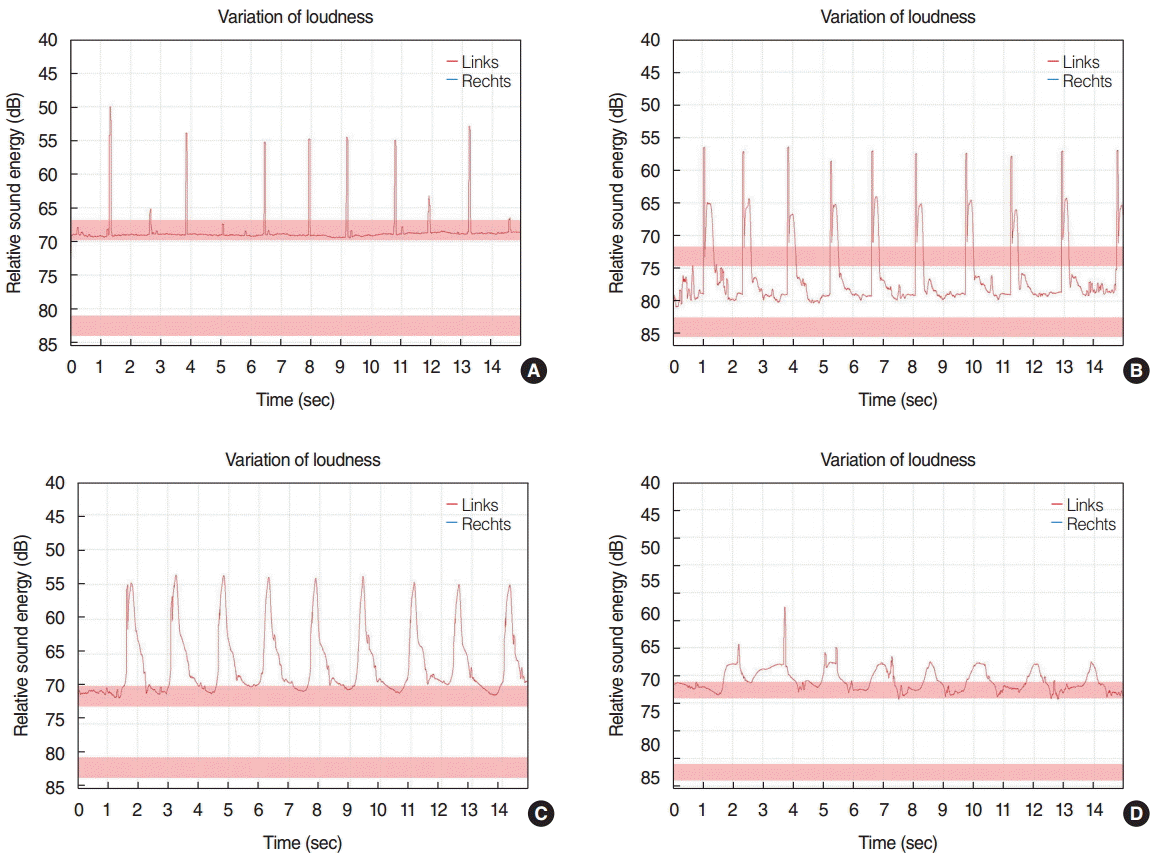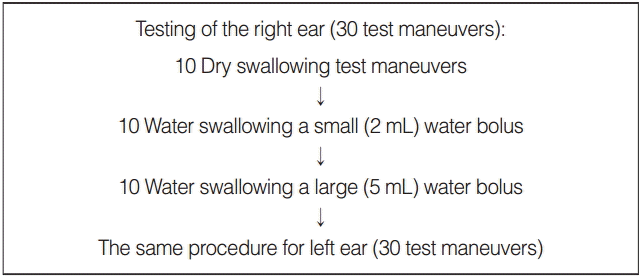1. Ockermann T, Reineke U, Upile T, Ebmeyer J, Sudhoff HH. Balloon dilation eustachian tuboplasty: a feasibility study. Otol Neurotol. 2010; Sep. 31(7):1100–3.
2. Martino E, Di Thaden R, Krombach GA, Westhofen M. Function tests for the Eustachian tube: current knowledge. HNO. 2004; Nov. 52(11):1029–39.
3. Browning GG, Gatehouse S. The prevalence of middle ear disease in the adult British population. Clin Otolaryngol Allied Sci. 1992; Aug. 17(4):317–21.

4. McDonald MH, Hoffman MR, Gentry LR, Jiang JJ. New insights into mechanism of Eustachian tube ventilation based on cine computed tomography images. Eur Arch Otorhinolaryngol. 2012; Aug. 269(8):1901–7.

5. Bluestone CD. The Eustachian tube: structure, function, and role in the middle ear. Hamilton (CA): BC Decker Inc.;2005.
6. Marchioni D, Mattioli F, Alicandri-Ciufelli M, Presutti L. Prevalence of ventilation blockages in patients affected by attic pathology: a case-control study. Laryngoscope. 2013; Nov. 123(11):2845–53.

7. Leuwer R, Schubert R, Wenzel S, Kucinski T, Koch U, Maier H. New aspects of the mechanics of the auditory tube. HNO. 2003; May. 51(5):431–7.
8. van Heerbeek N, Ingels KJ, Snik AF, Zielhuis GA. Reliability of manometric eustachian tube function tests in children. Otol Neurotol. 2001; Mar. 22(2):183–7.

9. Groth P, Ivarsson A, Tjernstrom O. Reliability in tests of the Eustachian tube function. Acta Otolaryngol. 1982; 93(1-6):261–7.

10. Bluestone CD, Cantekin EI. Current clinical methods, indications and interpretation of eustachian tube function tests. Ann Otol Rhinol Laryngol. 1981; Nov-Dec. 90(6 Pt 1):552–62.

11. van der Avoort SJ, van Heerbeek N, Zielhuis GA, Cremers CW. Sonotubometry: eustachian tube ventilatory function test. A state-of-the-art review. Otol Neurotol. 2005; May. 26(3):538–43.

12. Virtanen H. Sonotubometry: an acoustical method for objective measurement of auditory tubal opening. Acta Otolaryngol. 1978; Jul-Aug. 86(1-2):93–103.
13. Holmquist J, Bjorkman G, Olen L. Measurement of eustachian tube function using sonotubometry. Scand Audiol. 1981; Feb. 10(1):33–5.

14. Okubo J, Watanabe I, Shibusawa M, Ishikawa N, Ishida H, Teramura K. Sonotubometric measurement of the eustachian tube function by means of band noise: a clinical view of the acoustic measurement of the eustachian tube. ORL J Otorhinolaryngol Relat Spec. 1987; Feb. 49(5):242–52.
15. Jonathan D. The predictive value of eustachian tube function (measured with sonotubometry) in the successful outcome of myringoplasty. Clin Otolaryngol Allied Sci. 1990; Oct. 15(5):431–4.

16. Mondain M, Vidal D, Bouhanna S, Uziel A. Monitoring eustachian tube opening: preliminary results in normal subjects. Laryngoscope. 1997; Oct. 107(10):1414–9.

17. Di Martino EF, Thaden R, Antweiler C, Reineke T, Westhofen M, Beckschebe J, et al. Evaluation of Eustachian tube function by sonotubometry: results and reliability of 8 kHz signals in normal subjects. Eur Arch Otorhinolaryngol. 2007; Mar. 264(3):231–6.
18. Asenov DR, Nath V, Telle A, Antweiler C, Walther LE, Vary P, et al. Sonotubometry with perfect sequences: first results in pathological ears. Acta Otolaryngol. 2010; Nov. 130(11):1242–8.

19. Di Martino EF, Nath V, Telle A, Antweiler C, Walther LE, Vary P. Evaluation of Eustachian tube function with perfect sequences: technical realization and first clinical results. Eur Arch Otorhinolaryngol. 2010; Mar. 267(3):367–74.

20. Poe DS, Abou-Halawa A, Abdel-Razek O. Analysis of the dysfunctional eustachian tube by video endoscopy. Otol Neurotol. 2001; Sep. 22(5):590–5.

21. Poe DS, Grimmer JF, Metson R. Laser eustachian tuboplasty: two-year results. Laryngoscope. 2007; Feb. 117(2):231–7.

22. Schloegel L, Gottschall JA. Balloon dilation of the Eustachian tube: safety and utility. Otolaryngol Head Neck Surg. 2009; Sep. 141(3S1):134.
23. Poe DS, Silvola J, Pyykko I. Balloon dilation of the cartilaginous Eustachian tube. Otolaryngol Head Neck Surg. 2011; Apr. 144(4):563–9.

24. Takasaki K, Sando I, Balaban CD, Miura M. Functional anatomy of the tensor veli palatini muscle and Ostmann’s fatty tissue. Ann Otol Rhinol Laryngol. 2002; Nov. 111(11):1045–9.

25. Gaihede M, Dirckx JJ, Jacobsen H, Aernouts J, Sovso M, Tveteras K. Middle ear pressure regulation: complementary active actions of the mastoid and the Eustachian tube. Otol Neurotol. 2010; Jun. 31(4):603–11.
26. Bylander A, Tjernstrom O, Ivarsson A. Pressure opening and closing functions of the eustachian tube in children and adults with normal ears. Acta Otolaryngol. 1983; Jan-Feb. 95(1-2):55–62.

27. Honjo I. Eustachian tube in middle ear diseases. New York: Springer;1988.
28. Munro KJ, Benton CL, Marchbanks RJ. Sonotubometry findings in children at high risk from middle ear effusion. Clin Otolaryngol Allied Sci. 1999; Jun. 24(3):223–7.

29. van der Avoort SJ, Heerbeek Nv, Zielhuis GA, Cremers CW. Validation of sonotubometry in healthy adults. J Laryngol Otol. 2006; Oct. 120(10):853–6.

30. van der Avoort SJ, van Heerbeek N, Snik AF, Zielhuis GA, Cremers CW. Reproducibility of sonotubometry as Eustachian tube ventilatory function test in healthy children. Int J Pediatr Otorhinolaryngol. 2007; Feb. 71(2):291–5.






 PDF
PDF Citation
Citation Print
Print



 XML Download
XML Download